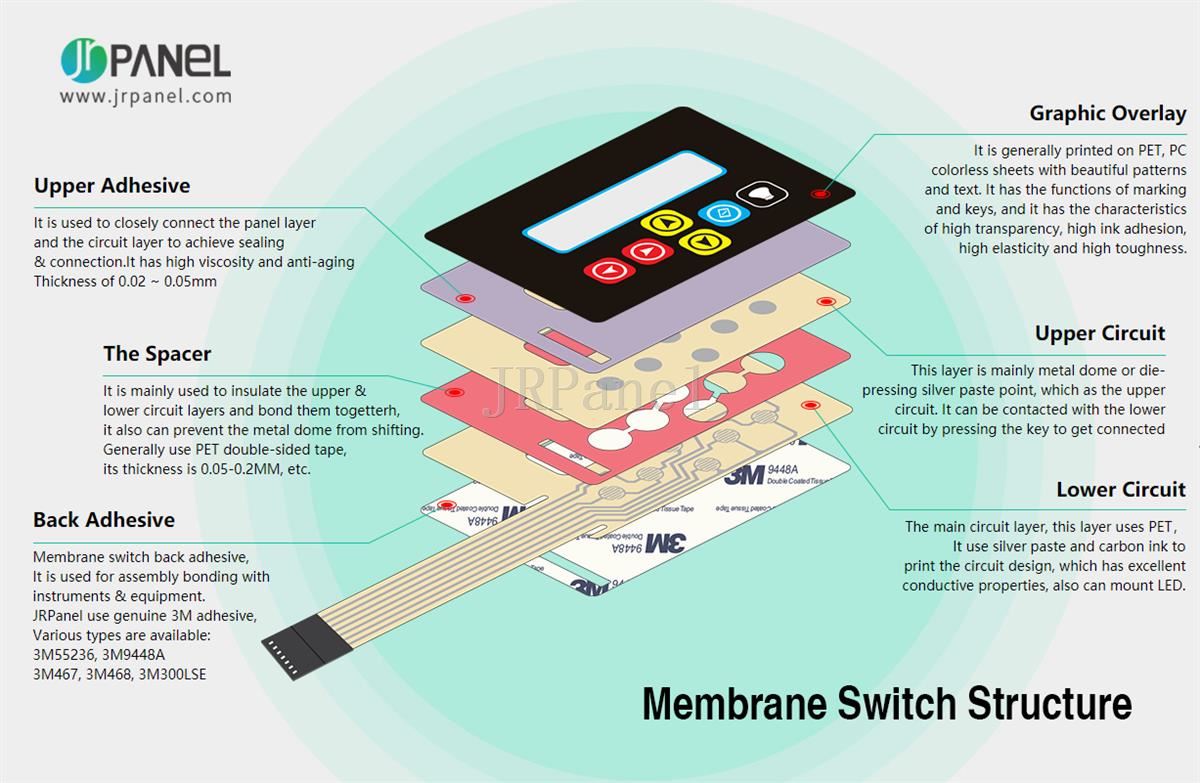The Manufacturing Refine Behind Membrane Switch Over: What You Required to Know
The production procedure behind membrane switches combines cautious layout, product choice, and top quality control. It starts with understanding the ins and outs of membrane layer switch style and advances through numerous phases, including product choices and printing methods. Each stage plays a necessary function in guaranteeing performance and durability. The intricacies of layer construction and the rigorous screening standards may expose insights that are not quickly evident. What lies past these fundamental aspects?
Recognizing Membrane Switch Over Layout
Although membrane layer buttons might appear simple at very first glance, their design includes intricate factors to consider that ensure capability and sturdiness. The design process starts with a comprehensive understanding of customer needs, including the user interface's desired application and ecological aspects. Ergonomics is a crucial element, as the layout has to assist in simplicity of usage while guaranteeing that responsive feedback meets user expectations.Moreover, the layering of components, such as visuals overlays, glue layers, and conductive traces, need to be precisely engineered. membrane switch. This split arrangement not just influences the button's responsiveness however also impacts its durability. Focus is provided to the sealing techniques employed to protect against wetness and dust, which might endanger performance. Additionally, design considerations reach aesthetics, where color pattern and visual clarity improve customer experience. Eventually, the style of membrane changes equilibriums functionality, individual experience, and toughness, making certain that they meet the needs of different applications effectively
Materials Made Use Of in Membrane Switch Over Manufacturing
When choosing products for membrane button manufacturing, it is necessary to consider both performance and durability. The primary materials consist of polyester and polycarbonate movies, which provide flexibility and toughness. These movies are typically coated with adhesive to ensure correct bonding to substratums. Conductive inks, usually composed of silver or carbon, are essential for creating electric connections within the switch, permitting trustworthy operation.Additionally, a protective layer, such as a tough layer, is often related to improve scratch resistance and longevity. The choice of backing product, such as acrylic or foam, can considerably impact the switch's responsive feel and general individual experience. Furthermore, numerous ecological variables, consisting of temperature level and moisture, must assist material choice to ensure peak performance in particular applications. Ultimately, the ideal combination of products contributes to the membrane button's capability and life expectancy, making educated choices crucial for suppliers.
The Printing Process: Creating Graphics and Text
The printing procedure in membrane switch manufacturing plays a significant function in generating top quality graphics and text. Different graphic style strategies are used to guarantee visual allure and performance, while cautious ink choice methods are necessary for durability and performance. Comprehending these elements is essential for accomplishing finest cause membrane switch style.
Graphic Style Techniques
Graphic style techniques play a vital duty in the printing process of membrane buttons, as they specify just how graphics and text will eventually appear on the last product. Reliable visuals style entails the calculated use of font styles, shades, and designs to improve readability and visual charm. Developers usually use vector graphics for scalability, making certain that images remain sharp at various dimensions. Furthermore, focus to contrast and alignment is vital, as it affects individual communication and visual quality. The consolidation of branding components, such as logo designs, have to be managed with care to maintain brand integrity. Overall, thoughtful visuals design strategies contribute significantly to the functionality and beauty of membrane layer buttons, affecting user experience and product efficiency.
Ink Selection Methods
Selecting the appropriate ink is necessary for attaining the wanted visual high quality and resilience in membrane layer button manufacturing. Various ink kinds are made use of, consisting of solvent-based, water-based, and UV-curable inks. Each kind offers distinct features, such as attachment, flexibility, and resistance to environmental aspects. Solvent-based inks are typically preferred for their toughness and lively shades, while water-based inks are more eco pleasant but may have limitations in adhesion. UV-curable inks give quick healing and durable efficiency. Furthermore, shade matching strategies guarantee that the chosen inks align with design specs. Inevitably, the selection of ink must consider elements such as application technique, substratum compatibility, and end-use needs to attain premium cause membrane layer button graphics and text.
Layer Construction and Setting Up

Product Choice Refine
A cautious option of products is necessary in the production procedure of membrane layer switches, as it straight influences performance and sturdiness. The key materials used consist of polyester, polycarbonate, and various conductive inks. Polyester is commonly preferred for its superb resistance to chemicals and abrasion, making it appropriate for harsh environments. Polycarbonate, on the other hand, offers superior clearness and impact resistance, which is useful for applications needing presence and effectiveness. Conductive inks, generally composed of silver or carbon, are crucial for creating trustworthy electrical paths. Additionally, the selection of adhesive materials impacts the general stability of the button - membrane switch. Reviewing factors such as environmental exposure, tactile responses, and aesthetic needs overviews manufacturers in selecting the most effective products for their details applications
Layer Adhesion Techniques
Adhering layers in membrane button construction is an essential procedure that guarantees capability and longevity. Different adhesion methods are employed to secure suitable bonding between layers, which usually include the use of adhesives, warm, and stress. Pressure-sensitive adhesives (PSAs) are generally used for their ease of application and immediate bonding abilities. Furthermore, thermal bonding techniques can be used, where warmth is utilized to turn on glue buildings, securing a strong bond. The choice of bond method greatly relies on the materials included and the specific application requirements of the membrane layer switch. Proper positioning and consistent application of adhesives are crucial to prevent issues, securing the switch runs effectively throughout its desired life-span.
Quality Assurance Measures
Ensuring quality assurance during the layer building and construction and assembly of membrane switches is vital for keeping efficiency and reliability. This procedure commonly includes numerous crucial actions, consisting of complete inspections at each stage of manufacturing. Makers utilize advanced testing techniques, such as you can try this out peel tests and adhesion assessments, to confirm the integrity of layer bonds. Additionally, aesthetic assessments are carried out to recognize any kind of defects in printing or product inconsistencies. Environmental conditions, such as temperature level and moisture, are thoroughly checked to guarantee perfect curing and attachment. Regular calibration of devices aids preserve exact manufacturing standards. By implementing these quality assurance procedures, manufacturers can substantially minimize the risk of product failure, ensuring that the final membrane switches over fulfill the called for specs and customer assumptions.
Checking and High Quality Control Actions

Developments in Membrane Change Modern Technology
As improvements in technology proceed to evolve, membrane switches are taking advantage of innovative growths that boost their capability and user experience. One remarkable technology is the assimilation of capacitive touch technology, which permits even more user-friendly and receptive interface. This change not only boosts appearances yet also reduces mechanical deterioration, extending the life expectancy of the switches.Additionally, innovations in graphic overlay products have caused improved toughness and resistance to ecological factors such as dampness and UV light. These materials currently supply enhanced clarity and illumination, further elevating the visual appeal.Furthermore, the consolidation of clever technology is transforming membrane layer switches over right into interactive control board, allowing connectivity with IoT devices. This connectivity their website fosters a smooth user experience, leading the way for applications in numerous sectors, from healthcare to consumer electronic devices. Collectively, these technologies setting membrane layer switches over as vital components in modern-day gadget style.
Frequently Asked Questions
For how long Does the Membrane Layer Switch Production Process Take?
The period of the membrane switch production process can vary considerably. Factors such as complexity, products made use of, and manufacturing quantity impact timelines, with common production ranging from a couple of days to numerous weeks for completion.
What Are the Common Applications for Membrane Layer Switches?
Membrane layer switches are generally used in different sectors, including auto controls, home devices, clinical tools, and customer electronic devices (membrane switch). Their convenience and durability make them ideal for applications requiring user-friendly interfaces and trusted performance in diverse atmospheres
Can Membrane Layer Switches Be Customized for Specific Demands?

What Is the Life-span of a Typical Membrane Switch Over?
The life expectancy of a typical membrane switch varies, however generally, it varies from 1 to 5 million cycles. Aspects such as use, environment, and material quality greatly influence durability and general efficiency in time.

Are Membrane Layer Switches Eco-friendly?
The ecological friendliness of membrane switches over varies. Some products made use of might not be recyclable, while others can be eco-friendly. The total impact depends on making materials and techniques, demanding careful factor to consider during selection and disposal. The production process behind membrane layer switches combines cautious style, material choice, and high quality control. It begins with recognizing the ins and outs wikipedia reference of membrane layer switch design and proceeds with numerous phases, consisting of material choices and printing methods. When picking materials for membrane layer switch manufacturing, it is crucial to ponder both efficiency and sturdiness. A cautious choice of products is vital in the production process of membrane layer switches, as it directly influences capability and resilience. The option of attachment method largely depends on the materials entailed and the specific application requirements of the membrane layer button.